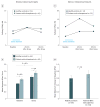Stress-induced increase in kynurenic acid as a potential biomarker for patients with schizophrenia and distress intolerance
- PMID: 24806441
- PMCID: PMC4219570
- DOI: 10.1001/jamapsychiatry.2014.243
Stress-induced increase in kynurenic acid as a potential biomarker for patients with schizophrenia and distress intolerance
Abstract
Importance: Several lines of evidence have linked the endogenous neuromodulator kynurenic acid (KYNA) to schizophrenia. The pathophysiology of schizophrenia is commonly associated with stress, and stress plays a key regulatory role in the first, rate-limiting step of the kynurenine pathway, which produces KYNA.
Objective: To determine whether the level of KYNA changes following psychological stress and whether this change is associated with stress-related behavior.
Design, setting, and participants: The KYNA level was measured in saliva samples taken at baseline and at 2 times following a laboratory-based psychological stress challenge in 128 participants (64 patients with schizophrenia from outpatient clinics and 64 healthy controls from the community).
Exposure: Laboratory-based psychological stress challenge.
Main outcomes and measures: Quitting the stressful task early was used as a behavioral marker of distress intolerance.
Results: Patients with schizophrenia showed a significantly higher rate of distress intolerance compared with healthy controls (P = .003). Salivary KYNA levels increased significantly between baseline and 20 minutes following the stress task in both patients and controls (mean [SEM], 6.72nM [0.65nM] vs 8.43nM [1.05nM], respectively; P = .007). Patients who were unable to tolerate the stressful tasks and quit early showed significantly higher levels of KYNA than patients who tolerated the psychological stressor (P = .02) or healthy controls (P = .02). In patients with distress intolerance, KYNA elevation significantly correlated with the severity of clinical symptoms (ρ = 0.64; P = .008).
Conclusions and relevance: Distress intolerance is more common in patients with schizophrenia. Patients with this behavioral phenotype have elevated salivary KYNA levels. This stress response behavior-linked biomarker may aid heterogeneity reduction in schizophrenia and other stress-related psychiatric conditions.
Conflict of interest statement
Figures



Comment in
-
Distress intolerance, kynurenic acid, and schizophrenia.JAMA Psychiatry. 2014 Jul 1;71(7):749-50. doi: 10.1001/jamapsychiatry.2014.518. JAMA Psychiatry. 2014. PMID: 24806109 Free PMC article. No abstract available.
References
-
- Schwarcz R, Rassoulpour A, Wu HQ, Medoff D, Tamminga CA, Roberts RC. Increased cortical kynurenate content in schizophrenia. Biol Psychiatry. 2001;50(7):521–530. - PubMed
-
- Nilsson LK, Linderholm KR, Engberg G, et al. Elevated levels of kynurenic acid in the cerebrospinal fluid of male patients with schizophrenia. Schizophr Res. 2005;80(2–3):315–322. - PubMed
Publication types
MeSH terms
Substances
Grants and funding
LinkOut - more resources
Full Text Sources
Other Literature Sources
Medical

